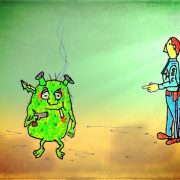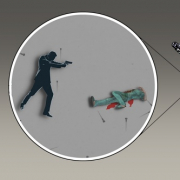Here Comes Peter Cottontail, Hoppin’ Down The Murder Trail
“Yes, Sam, you heard me correctly. The murder weapon was indeed a wisecracking, bucktooth bunny.”
“Don’t be silly, Daffy. I can’t imagine how she could bludgeon the man to death using a long-eared galoot.”
“No more speculation, please,” said the famous cartoon duck. “Here’s how she did it …”
Tularemia
Tularemia, or rabbit fever as it’s commonly called, is no stranger to the United States. After its discovery in 1911 in Tulare, California, the disease became known as a killing machine. It killed a large number of ground squirrels before finding its way into human bodies where it infected hunters and other outdoorsmen, and any others who came into contact with infected animals.
Today, the Center for Disease Control (CDC) reports roughly 200 cases of Tularemia (Francisella tularensis) each year in America. Only about two percent of those cases are fatal. However, since it is possible to transform the tularemia microbe to an aerosol form, the plague-like disease could be used as a very effective biological weapon.
Killers in mystery novels might find tularemia a most effective way to murder their victims, since pathologists and toxicologists do not routinely screen for it during autopsy. And, Tularemia is not easily detected by doctors.
Tularemia-carrying organisms are readily found in wild animals—particularly feral rabbits—in their feces. It’s also found in water and mud. Humans can contract tularemia by handling the hides, paws, or flesh of wild rabbits. They can also catch the disease by eating undercooked rabbit meat. Ticks, mosquitoes, and deer flies can transfer the sickness to humans through their bites.
A hunter with an open cut or wound can contract tularemia simply by skinning a rabbit. A murderous spouse could introduce the bacteria into her unsuspecting hunter-husband’s food (Tularemia-tainted meat), then blame the death on the infected rabbits the sportsman shot during his hunt. The wife could easily explain the symptoms away until her husband was too far-gone for medical help.
The disease offers a variety of symptoms, depending upon the way it is introduced to the victim. Inhaled tularemia, the method most likely to be used by terrorists, presents flu-like symptoms—fever, chills, loss of appetite, cough, and headache. Swollen lymph nodes, skin ulcers, and pneumonia can accompany these symptoms.
Certain strains of tularemia are currently incurable because they have been genetically engineered to be antibiotic-resistant. This disease, though deadly, cannot be spread by human-to-human contact.
The use of tularemia in germ warfare is not new to the military. In 1932 and again in 1945, the Japanese studied using tularemia as a possible biological weapon. Thousands of Soviet and German soldiers serving on the Eastern front during WWII succumbed to tularemia. There is some speculation that the disease was introduced to them intentionally.
The U.S. also developed and stockpiled tularemia (by freezing). The military conducted tests on the agent (code named Agent UL) by spraying barges containing monkeys in the waters off Hawaii. The spray was introduced by aircraft over several miles. As a result, over half the monkeys were infected with tularemia. Approximately half of the infected monkeys died.
An American fell ill with Tularemia when he ran over an infected rabbit while mowing his lawn. It was this instance that cemented the fact that tularemia could be contracted by inhalation. In 2000, an outbreak of tularemia occurred on Martha’s Vineyard. The cause of the outbreak .. lawn mowing. In 2003, a Nantucket maintenance worker ran over an infected rabbit with his lawnmower, however, it was not he who contracted the disease. Instead, it was a co-worker who used a stick to remove the animal to nearby bushes.
Terrorists could transmit the bacteria either in food or by an aerosol propellant. Large numbers of people could be infected at once with only a microscopic amount of the bacteria.
So, what have we learned from all this? That’s right, be vewy, vewy quiet when hunting wabbits …









